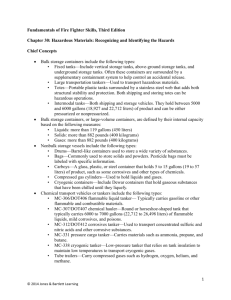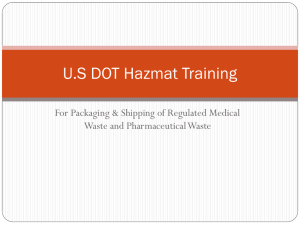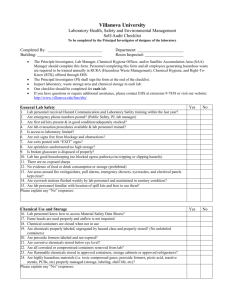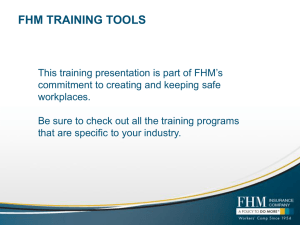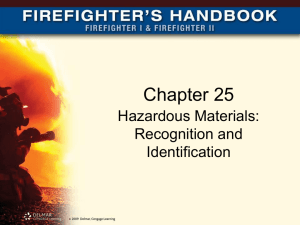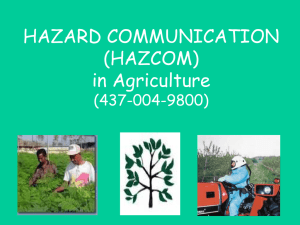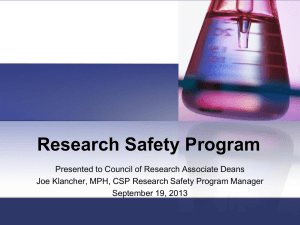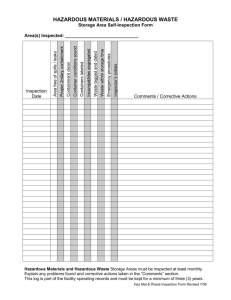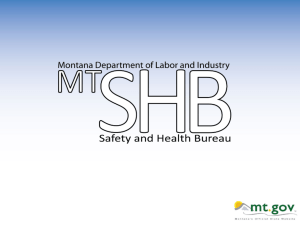HazMat Powerpoint
advertisement
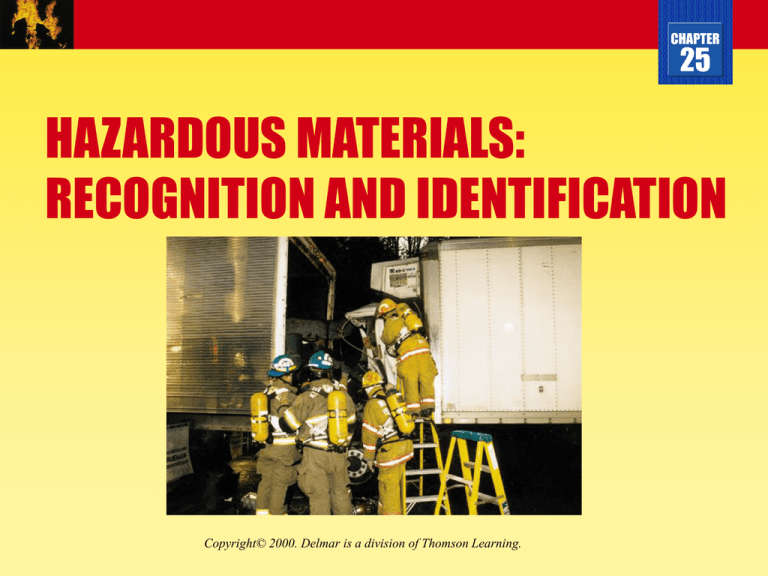
CHAPTER 25 HAZARDOUS MATERIALS: RECOGNITION AND IDENTIFICATION Copyright© 2000. Delmar is a division of Thomson Learning. CHAPTER 25 Objectives 1 of 3 • Identify the nine hazard classes as defined by DOT. • Identify the hazards associated with each hazard class. • Identify the standard occupancies where hazardous materials may be used and stored. CHAPTER 25 Objectives 2 of 3 • Identify the standard container shapes and sizes and common products. • Identify both facility- and transportation- related markings and warning signs. • Identify the standard transportation types for highway and rail. CHAPTER 25 Objectives 3 of 3 • Explain the NFPA 704 System. • Explain the use of transportation containers in identifying possible contents. • Explain the location of emergency shutoff valves on highway containers. • Explain the importance of understanding chemical and physical properties of hazardous materials. CHAPTER 25 Introduction • Four basic clues to recognition and identification: • Location and occupancy. • Placards, labels, and markings. • Container types. • The use of senses. CHAPTER 25 Location and Occupancy • Average home has a large amount of hazardous materials. • Rural communities and farms have unique risks. • Hazardous materials storage. • Businesses present a wide range of risks. CHAPTER 25 Agricultural Supply Store CHAPTER 25 Roadway CHAPTER 25 Placards, Labels, and Markings CHAPTER 25 CHAPTER 25 CHAPTER 25 Placards • DOT - 49 CFR 170-180. • DOT system uses nine hazard classifications with more than 27 placards. • DOT also requires United Nations/North America (UN/NA) identification number. CHAPTER 25 Class 1, Explosives • Division 1.1 • Division 1.2 • Division 1.3 • Division 1.4 • Division 1.5 • Division 1.6 CHAPTER 25 Class 2, Gases • Division 2.1 • Division 2.2 • Division 2.3 • Hazard Zone A • Hazard Zone B • Hazard Zone C • Hazard Zone D CHAPTER 25 Class 3, Flammable Liquids • Flash point less than 141 degrees F. • Combustible liquids are those with flash points between 100-200 degrees F. CHAPTER 25 Class 4, Flammable Solids • Division 4.1 • Division 4.2 • Division 4.3 CHAPTER 25 Class 5, Oxidizers and Organic Peroxides • Division 5.1 • Division 5.2 • Type A • Type B • Type C • Type D • Type E • Type F • Type G CHAPTER 25 Type 6, Poisonous Materials • Division 6.1 • Division 6.2 • Hazardous Zone A • Hazardous Zone B CHAPTER 25 Class 7, Radioactive Materials • Materials determined to have radioactivity at certain levels. • Radioactive I. • Radioactive II. • Radioactive III. CHAPTER 25 Class 8, Corrosives • Acids • Bases • Visible destruction in skin or corrodes steel or aluminum. CHAPTER 25 Class 9, Miscellaneous Hazardous • Catchall category. CHAPTER 25 Other Placards and Labels • • • • • Dangerous Specific name Stow away from foodstuffs ORM-D Marine Pollutant • • • • Elevated temperature Infectious substances Fumigated Residue CHAPTER 25 LABELS CHAPTER 25 NFPA 704 • • • • Health hazard – Blue. Fire hazard – Red. Reactivity hazard – Yellow. Special Hazard – White. CHAPTER Hazardous Materials Information System 25 CHAPTER 25 Military Warning Signs CHAPTER 25 Pipeline Markings CHAPTER 25 Container Markings CHAPTER 25 Pesticide Container Markings CHAPTER 25 Containers • • • • Hazardous materials come in variety of containers. Type of material and use determine packaging. Type of container provides clues to contents. Be alert for anything unusual. CHAPTER 25 MC-331 Pressurized Tanker CHAPTER 25 Containers CHAPTER 25 Containers • • • • • • • Cardboard boxes Bottles Bags Drums Cylinders Totes Bulk tanks CHAPTER 25 Pipelines • Vary in size and pressure. • Sized between 1⁄2 inch and more than 6 feet. • Can originate from bulk storage facilities. • Can cross many states. CHAPTER 25 Highway Transportation Containers • • • • Type of vehicle is a clue to contents. Four basic truck types. Leakage is often found in intermodal containers. Tank trucks carry up to 10,000 gallons. CHAPTER 25 DOT-406/MC-306 Gasoline Tank Truck CHAPTER 25 DOT-407/MC-307 Chemical Hauler CHAPTER 25 DOT 412/MC 312 Corrosive tanker CHAPTER 25 BLEVE CHAPTER 25 MC-338 Cryogenic Tankers CHAPTER 25 Tube Trailers CHAPTER 25 Dry Bulk Tanks CHAPTER 25 Hot Materials Tanker CHAPTER 25 Intermodal Tanks CHAPTER 25 Nonpressurized Railcar CHAPTER 25 Specialized Railcars CHAPTER 25 Markings on Railcars CHAPTER 25 Specialized Tanks CHAPTER 25 Senses • Vision and hearing are acceptable senses in investigating potential chemical releases. • Sensory clues from others are useful. • Many toxic materials can be harmful if touched. CHAPTER 25 Chemical and Physical Properties • • • • • • States of matter. Vapor pressure. Vapor density. Specific gravity. Corrosivity. Chemical reactivity. • • • • Flashpoint. Autoignition temperature. Flammable range. Toxic products of combustion. CHAPTER 25 States of Matter CHAPTER 25 Vapor Pressure CHAPTER 25 Vapor Density CHAPTER 25 Specific Gravity CHAPTER 25 Wrap-Up • Ability to recognize hazardous materials is important. • Memorization is not important, but knowing how to access information is. • Physical properties of chemicals will affect how they react and should be managed. • Firefighters must be able to use available resources.
